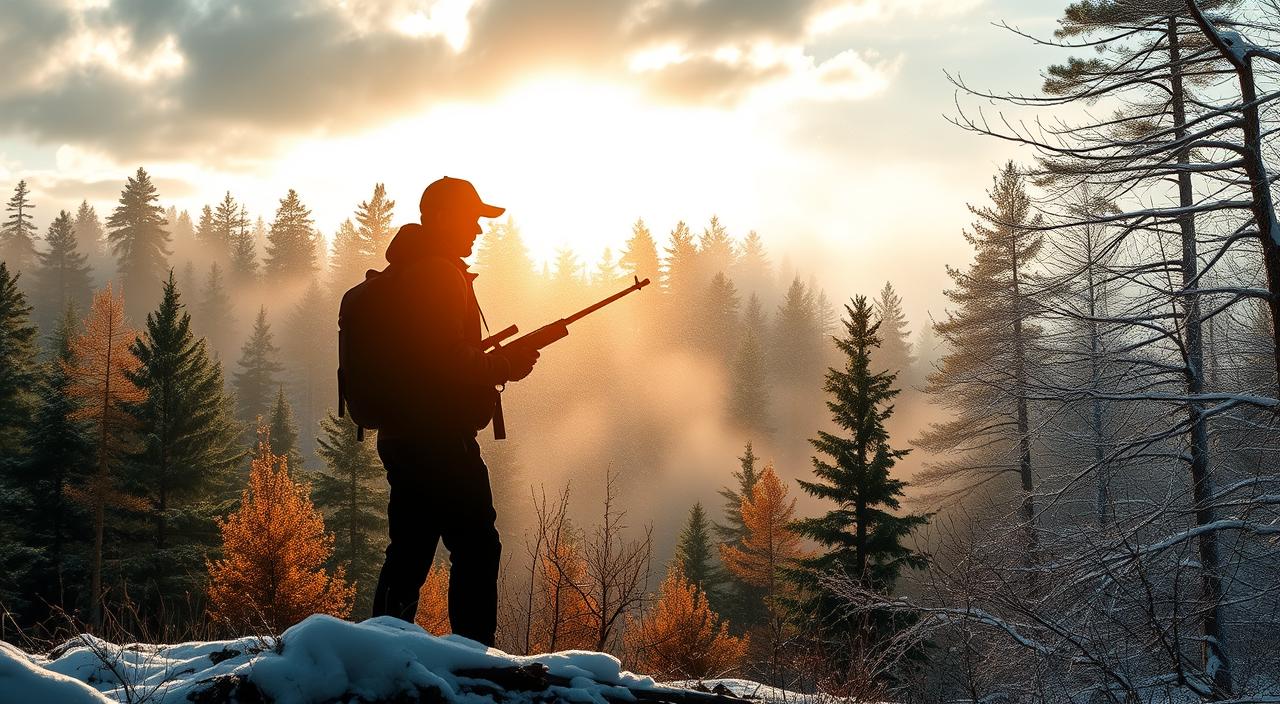Many ungulate populations have grown in Europe and North America. This is due to better food and habitats from climate changes and fewer natural predators. Hunting is now a key way to manage these populations. Knowing how weather affects hunting is important for better management.
This article will look at how weather and other factors change hunting success and deer behavior.
Key Takeaways
- Weather conditions significantly impact deer behavior and movement, affecting hunting success.
- Barometric pressure, temperature, precipitation, and wind speed are key weather factors influencing deer activity.
- Hunters need to adapt their strategies to account for the effects of weather and seasonal changes on deer behavior.
- Understanding the relationship between weather and hunting is crucial for effective wildlife management and adaptive decision-making.
- Potential impacts of climate change on hunting patterns and success rates should be considered for long-term planning.
Introduction to Weather and Hunting
Success in hunting depends on many things, like the hunter’s skills, the prey’s behavior, and the weather. Weather is key in hunting success. Studies show how weather affects deer and other prey.
Importance of Weather for Hunting Success
Weather affects when hunters go out and how animals move. For example, deer are seen less when it’s hot and more when it rains. Knowing this helps hunters plan better.
Factors Affecting Hunter Decisions and Animal Behavior
Hunters think about the weather before they go out. Temperature, rain, and wind can change their success. Deer and other animals also change their behavior with the weather. Understanding these complex relationships is crucial for developing effective hunting strategies and adapting to the challenges posed by climate change.
“Successful hunting is not just about skill and marksmanship; it’s about reading the signs of nature and anticipating the responses of your quarry to the ever-changing weather patterns.”
As climate change changes the world, knowing how weather affects hunting will be more important. Hunters and wildlife managers need to adapt to keep hunting sustainable and protect the ecosystem.
Effect of Temperature on Hunting
The temperature greatly affects deer activity and hunting success. Hunters know how temperature changes impact deer behavior.
Impact of High Temperatures on Deer Activity
High temperatures make deer less active. They seek cooler, shadier spots to stay comfortable. This can make them harder to find during the day.
Influence of Cold Temperatures on Deer Movement
Cold weather also changes deer behavior. In winter, they stay in warmer, forested areas to save energy. This makes them harder to track.
Temperature affects hunting success, but deer react more to temperature changes than specific numbers. By watching temperature trends and adjusting their plans, hunters can do better.
| Temperature Range | Deer Activity | Hunting Success |
|---|---|---|
| High Temperatures | Reduced activity, seeking cooler areas | Decreased hunting success |
| Low Temperatures | Conserving energy, less movement | Decreased hunting success |
| Moderate Temperatures | Increased activity and movement | Improved hunting success |
Understanding how temperature affects deer activity and hunting success helps hunters. They can adjust their plans to better match the temperature impact on deer and increase their chances of a successful hunt.
Precipitation and Its Role
The effect of rain on hunting success is complex. Heavy rain might lower hunter spirits and make deer harder to spot. But, a light drizzle could get deer moving, making hunting easier. It’s key to know how different rains affect hunters and deer to hunt better.
Rain’s Impact on Hunting
Studies show deer don’t mind rain much. They might even move a bit more in light rain. But, this can change based on where you are and the environment.
Light rain might make deer more active. It could wash away scents and help deer smell better. But, heavy rain can make hunting tough. It lowers hunter spirits, hides deer, and affects safety.
A survey found many think rain stops deer from moving. But, others believe it doesn’t affect them. Weather in October 2013 showed that rain and cold together really impact deer.
To hunt well, you need to understand rain, temperature, and deer behavior. This knowledge helps hunters, whether they’re after waterfowl or whitetail deer.
Wind Speed and Hunting Success
The impact of wind on hunting success is huge. Whitetail deer, the most hunted big game in North America, rely heavily on their senses. Their sense of smell is key for hunters to beat. Studies show that deer’s movement and behavior change with wind speed.
Deer move more on moderately windy days. The wind noise helps hide their scent from predators. But on very windy nights, they move less. This is because they can’t detect threats as well. Hunters need to adjust their tactics based on wind to succeed.
Deer Behavior and Wind
Many studies have looked into how wind affects deer. A South Texas study found deer move most in light winds. They move less in winds of 15-19 mph, then more again over 20 mph. A Pennsylvania study showed deer move more on windy days but less at night, especially if it’s not raining.
| Wind Speed | Deer Movement |
|---|---|
| 0-4 mph | Increased movement |
| 15-19 mph | Decreased movement |
| 20+ mph | Increased movement |
While studies show different effects of wind on deer, they all agree wind is key to hunting success. By understanding deer’s wind responses, hunters can plan better. This helps increase their chances of a successful hunt.
“Knowing how to adapt hunting tactics to different wind conditions is important for maximizing hunting success.”
Weather hunting impact
The weather greatly affects how hunters decide to hunt and how deer behave. Things like temperature, rain, wind, and snow depth play big roles. They can change whether hunters go out, if they see deer, and how well they hunt.
For example, the 2020 Iowa derecho had a big impact on deer. The storm knocked down trees, but the fallen timber helped deer. This shows how weather affects the whole ecosystem and hunting plans.
Barometric pressure is also important for hunting. High pressure means clear skies, which is great for hunting. But when pressure drops, deer get active, looking for food and shelter before a storm. Adjusting hunting plans to these weather changes can really help hunters succeed.
| Barometric Pressure Reading | Deer Activity | Hunting Conditions |
|---|---|---|
| 30.0 (high pressure) | Normal | Clear, calm |
| 30.2+ (high pressure) | Increased | Ideal |
| Dropping (before storm) | Increased | Favorable |
Special gear like Stump blinds can help hunters deal with changing weather. They are made of tough polyethylene and keep hunters dry and comfortable. Knowing how weather affects hunting helps hunters make better choices and do better in the field.
Influence of Snow Depth
As winter comes, snow depth greatly affects deer behavior and hunting success. Deer change their movements and where they live based on snow. Knowing these changes can help hunters do better.
Deer Behavior in Response to Snow Accumulation
Deer look for places with less snow because deep snow is hard to move through. When snow is low, they like younger forests with easier-to-reach food. But as snow gets deeper, they move to denser forests for better shelter and easier travel.
Research shows deer prefer south-facing slopes with dense forests when snow is really deep. This helps them save energy and find food more easily. In winter, deer stay in smaller areas than in warmer months.
| Deer Behavior | Low Snow Depth | High Snow Depth |
|---|---|---|
| Habitat Preference | Young 2nd growth forests | Old 2nd growth and productive old-growth forests |
| Movement | Less restricted home ranges | Highly restricted home ranges |
| Energy Expenditure | Lower (474-488 J/g/m) | Higher (283-287 J/g/m) |
Changing hunting strategies to fit deer’s snow patterns is key to success. By understanding how deer movement in snow changes their behavior, hunters can find the best spots. This leads to better snow depth impact on hunting.
Weekday vs. Weekend Hunting
Whitetail deer hunting success can vary based on the day of the week. Deer move differently on weekdays than on weekends. Knowing these patterns can help hunters make the most of their time outdoors.
Hunting pressure affects deer behavior. They are more active on Thursdays and Fridays when hunting is less common. This is because deer avoid the increased human activity on Saturdays and Sundays.
| Day of the Week | Deer Activity Levels | Hunting Success Rates |
|---|---|---|
| Weekdays (Monday – Friday) | Higher daytime activity | Potentially higher |
| Weekends (Saturday – Sunday) | Lower daytime activity | Potentially lower |
Planning hunting trips with the day of the week in mind can boost success. Weekday hunts might be better in areas with lots of hunters. Deer are more active during the day when there are fewer hunters. Weekend hunts might need different tactics to catch deer at night to avoid humans.
Understanding deer movement patterns, like how hunting pressure affects them, helps hunters improve their success. By adapting their strategies, hunters can increase their chances of a successful hunt.
Driven Hunts and Weather Effects
Driven hunts are seen as less affected by weather. But, our study shows that weather still plays a big role. Even the best-planned hunts can be changed by the weather.
Driven hunts can adjust to weather forecasts a bit. But, deer behavior is still affected by the weather during the hunt. This means weather affects deer, not just the hunters’ plans.
Planned Nature of Driven Hunts and Weather Influence
Even well-planned driven hunts are affected by the weather, our analysis found. This shows how important weather is for hunting success.
Weather like temperature, rain, and wind can greatly impact deer. Hunters need to stay alert and adjust to weather changes to succeed.
“The planned nature of driven hunts allows for some adaptation to weather forecasts, but deer movements and activity patterns remain influenced by weather parameters during the actual hunt.”
Adaptive Management and Climate Change
Climate change is changing the natural world fast. This makes adaptive wildlife management more important than ever. Hunting, a key way to manage wildlife, needs to change too. It must keep up with weather, deer behavior, and hunter choices.
Importance of Understanding Weather-Hunting Relationship
Hunting is key for many deer species. Knowing how weather affects hunting is vital. By watching how weather changes deer and hunter actions, managers can plan better for the future.
Potential Impacts of Climate Change on Hunting
Climate change will change hunting a lot. It will alter deer habits, hunting conditions, and what hunters can do. Using weather data in hunting plans is crucial for adapting to these changes.
By using adaptive wildlife management, hunters can help with climate change effects on hunting. Understanding weather-deer-hunter dynamics helps hunters and managers keep wildlife healthy. This way, hunting can continue for future generations.
Conclusion
This detailed look at how weather affects hunting has given us important insights. It shows how temperature, rain, wind, and snow impact deer and hunters. This knowledge helps us manage wildlife better.
Deer move more on windy days than calm ones, but less at night. This means hunters should use wind data in their plans. Windy days can make hunting more successful. Climate change also affects wildlife and hunting, so we need to adapt to keep things sustainable.
Knowing how weather, deer, and hunters interact helps us hunt better. It also helps protect wildlife as the climate changes. The main points from this study stress the need to use weather and climate data in wildlife management.

